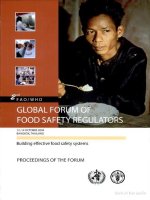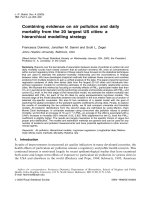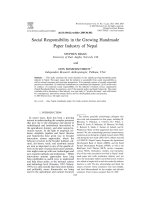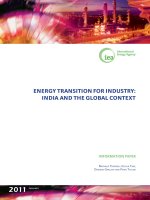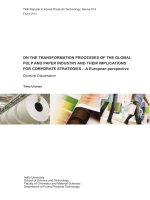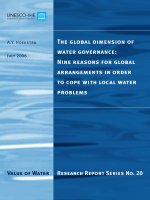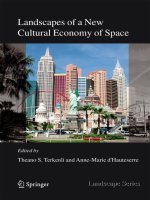- Trang chủ >>
- Khoa Học Tự Nhiên >>
- Vật lý
social economy of the metropolis cognitive-cultural capitalism and the global resurgence of cities jan 2009
Bạn đang xem bản rút gọn của tài liệu. Xem và tải ngay bản đầy đủ của tài liệu tại đây (2.34 MB, 197 trang )
Social Economy of the Metropolis
“The world [is] a progressively realized community of inter-
pretation”
Josiah Royce (1913: 394)
Social Economy of the
Metropolis
Cognitive-Cultural Capitalism
and the Global Resurgence
of Cities
Allen J. Scott
1
3
Great Clarendon Street, Oxford ox2 6DP
Oxford University Press is a department of the University of Oxford.
It furthers the University’s objective of excellence in research, scholarship,
and education by publishing worldwide in
Oxford New York
Auckland Cape Town Dar es Salaam Hong Kong Karachi
Kuala Lumpur Madrid Melbourne Mexico City Nairobi
New Delhi Shanghai Taipei Toronto
With offices in
Argentina Austria Brazil Chile Czech Republic France Greece
Guatemala Hungary Italy Japan Poland Portugal Singapore
South Korea Switzerland Thailand Turkey Ukraine Vietnam
Oxford is a registered trade mark of Oxford University Press
in the UK and in certain other countries
Published in the United States
by Oxford University Press Inc., New York
© Allen J. Scott, 2008
The moral rights of the author have been asserted
Database right Oxford University Press (maker)
First published 2008
All rights reserved. No part of this publication may be reproduced,
stored in a retrieval system, or transmitted, in any form or by any means,
without the prior permission in writing of Oxford University Press,
or as expressly permitted by law, or under terms agreed with the appropriate
reprographics rights organization. Enquiries concerning reproduction
outside the scope of the above should be sent to the Rights Department,
Oxford University Press, at the address above
You must not circulate this book in any other binding or cover
and you must impose the same condition on any acquirer
British Library Cataloguing in Publication Data
Data available
Library of Congress Cataloging in Publication Data
Scott, Allen John.
Social economy of the metropolis: cognitive-cultural capitalism and the
global resurgence of cities / Allen J. Scott.
p. cm.
ISBN 978–0–19–954930–6
1. Sociology, Urban. 2. Cities and towns—Growth. 3. Capitalism. I. Title.
HT153.S59 2008
307.76—dc22 2008016910
Typeset by SPI Publisher Services, Pondicherry, India
Printed in Great Britain
on acid-free paper by
Biddles Ltd., King’s Lynn, Norfolk
ISBN 978–0–19–954930–6
13579108642
Preface
Many if not most social scientists today would probably be ready
to acknowledge the broad claim that capitalism somehow or other
paves the way for large-scale urban growth and development. Beyond
this vague putative consensus, however, urban studies at the present
time is a cacophony of divergence and disagreement, understandably
so, perhaps, in view of the fact that cities are implicated in virtually
every dimension of modern life. My purpose in this book is not
to range across this entire domain of academic discussion, much
less to provide a comprehensive review of the current state of the
field. I propose, rather, to argue in favor of a few basic principles
that I believe provide some critical foundations for refocusing urban
theory on the essential nature of urbanization in capitalism and then
to deploy these principles in an investigation of urban growth and
development patterns in the current conjuncture.
My point of departure in the latter task resides in the general claim
alluded to above, and specifically in the rather more controversial
idea that modern cities are in the first instance dependent expressions
of the logic and dynamics of the wider economic environment. This
point of departure must immediately be qualified by reference to
a second basic premise about the nature of urbanization, for cities
are not just simple, passive excrescences of the capitalist economy.
To the contrary, they also play an intrinsically active role in the
unfolding of the economic order, both directly and indirectly (via
diverse extra-economic conditions of existence). In the absence of
urbanization, capitalism as we know it would be a very much more
low-key affair, if it could exist at all. In other words, yes, modern
cities make their historical appearance and develop as a consequence
of capitalist economic dynamics, but they are also critical moments
in the continuation of capitalism as a going concern. This dual role
of cities is, of course, an expression of the wider patterns of circular
v
Preface
and cumulative causation that underlie the formation of virtually the
entire space-economy of the modern world.
The intimate recursive connection between urbanization and capi-
talist society at large means that every historical version of capitalism
is associated with distinctive types of cities, and vice versa. The first
machine age in the nineteenth century was founded on a peculiar
kind of urbanization composed of tightly knit agglomerations of fac-
tories and workshops intertwined with dense tracts of cheap housing
where the largely impoverished proletariat eked out a living. The
second machine age, with its core technological-cum-organizational
bases residing in mass production and large-scale growth poles, was
typified by the formation of extended metropolitan areas and by
a dominant division of urban social space into white-collar and
blue-collar neighborhoods, itself a reflection of the basic division
of labor in fordist society. The third machine age, which began to
emerge some time toward the late 1970s and early 1980s, is now
bringing forth a number of startlingly novel forms of economic and
social organization based in significant ways on new technologies of
computation and information, and cities are once again responding
to this state of affairs in their double role as both outcomes and
fountainheads of economic development. The current moment, I
shall argue, is one in which a specifically cognitive-cultural economy
has made its historical appearance, with profound consequences for
the configuration of contemporary urbanization and urban social life.
Even as the cognitive-cultural economy proliferates across the globe,
cities represent the crucibles in which the new economic order is
being forged and in which many of its essential bases are assembled
into local socioeconomic systems.
The present book is an effort to put some conceptual and descrip-
tive order around these different claims. The argument proceeds on
three main registers. First, I examine some of the essentials of urban
theory generally, with the broad objective of rearticulating the urban
question in a way that is relevant to today’s world, and where by
the term “urban question” I mean an explicit fusion of a scientific
problematic and a political project directed, on the one side, to the
comprehension, and on the other side, to the progressive recon-
struction of urban life. I argue that while the urban question quite
properly changes its shape and form from time to time depending
on conjunctural circumstances, it is nevertheless durably rooted in
vi
Preface
a systematic logic that reflects the tension-filled dynamics of urban
space. Second, I offer a variety of theoretical and empirical observa-
tions about the functional characteristics of today’s cognitive-cultural
economy as manifest in sectors like technology-intensive production,
financial and business operations, fashion-oriented manufacturing,
cultural industries, personal services, and so on. These sectors are
growing with great rapidity in the world’s largest cities at the present
time, and they play an important role in the great urban resurgence
that has occurred over the last few decades all across the globe.
Third, I explore the detailed spatial ramifications of the cognitive-
cultural economy in contemporary cities and the ways in which it
intersects with many other kinds of urban processes. In particular,
the cognitive-cultural economy appears to be ushering in major
shifts in the division of labor and social stratification in capitalist
society, as marked by a growing divide between a privileged elite
stratum of workers (managers, professionals, technicians, etc.) on
the one side, and a kind of new lumpenproletariat on the other,
and this state of affairs, of course, is pregnant with consequences
for the social life of cities. In all of this, I lay special emphasis
on the idea of the social economy of the metropolis, which is to
say, a view of the urban organism as an intertwined system of
social and economic life played out through the arena of geographic
space.
I should add that as the investigation proceeds, empirical points
of reference are for the most part confined to North American cities,
but frequent allusions are also made to cities in other parts of the
world, and in the final analysis, my purpose is to provide a fairly
comprehensive synthesis of the issues. With this end in mind, the
penultimate chapter of the book seeks to throw a sharp light on the
ways in which urbanization in general is today caught up in a series
of complex interrelations between the cognitive-cultural economy
and processes of globalization. One striking expression of this state
of affairs can be observed in the emergence of selected city-regions
as economic and cultural flagships of the new world order. I am
concerned in this book not only to provide a few guidelines as to
how we might approach these matters but also to work out a number
of suggestions about the political issues and tasks of reform that are
becoming increasingly urgent in large cities consequent upon the rise
of a globalizing cognitive-cultural economy.
vii
Preface
Even so, I am conscious that the basic terrain of analysis under
scrutiny here is extraordinarily complex and conceptually challen-
ging and that my attempt to deal with it is provisional at best.
I recognize, too, that my stress on the economic dimensions of
urbanization—even if the economic is constantly qualified by refer-
ence to the social—will not be to the taste of those numerous scholars
today who tend to emphasize more culturally inflected forms of
urban analysis. My objective is not to deny the significance of cultural
variables in the shaping of modern cities, much less to treat them
as residual consequences of economic life. I am more than ready to
acknowledge that culture as construed by latter-day culture theorists
has many far-reaching effects on the economy in general and has
notably powerful impacts on how cities function and look. Indeed,
the quotation from Royce that stands at the head of this book points
already to this admission, for one of my concluding propositions is
that economy and culture appear to be converging together into new
and peculiar structures of meaning whose focal points are the great
city-regions of the global era. All that being said, I am nevertheless
intent in what follows on an attempt to assert the essential genesis
of contemporary forms of urbanization in the capitalist economic
order, an objective that I seek further to justify and to realize in
Chapters 1 and 2. It is my hope that the modest contribution to
urban analysis put forth here will help to spark off further extended
research and debate, for the issues to which I allude are of some
conceptual significance, and, in more concrete terms, they refer to
a number of major practical challenges for cities and society at large
in the looming era of cognitive-cultural capitalism.
Part of the material of the book has been previously published in
the following journals: Annals of Regional Science, European Planning
Studies, Internal Journal of Urban and Regional Research, Journal of Urban
Affairs, Social Forces, Urban Affairs Quarterly,andUrban Studies.Iam
grateful to the publishers of these journals for permission to repro-
duce extended passages here. However, all of the material reproduced
in this book has been significantly edited, recombined, and rewritten
for the purposes of the present volume, and a considerable amount of
new content has been added. The argument as a whole, therefore, is
very much more complex and goes significantly beyond the already
published work in which it has its roots. I also wish to express my
gratitude to the National Science Foundation (specifically for grant
viii
Preface
number BCS-0749038), the Richard S. Ziman Center for Real Estate
at UCLA, and the Committee on Research of the Academic Senate
also at UCLA for research funding that has enabled me to carry out
detailed investigations of a number of the basic themes that are
explored below. Finally, I thank my friends and colleagues David
Rigby and Michael Storper for their helpful comments on early drafts
of sections of this book.
AJS
ix
This page intentionally left blank
Contents
List of Illustrations xii
List of Tables xiii
1. The Resurgent City 1
2. Inside the City 19
3. Production and Work in the American Metropolis 41
4. The Cognitive-Cultural Economy and the Creative City 64
5. Culture, Economy, and the City 84
6. Chiaroscuro: Social and Political Components of the
Urban Process 110
7. City-Regions: Economic Motors and Political Actors
on the Global Stage 130
8. Coda 149
References 157
Index 173
xi
List of Illustrations
3.1. Correlogram showing relations between different CMSA/MSA
population size categories in regard to occupational structure 60
4.1. Selected industrial districts in Los Angeles and adjacent counties 71
5.1. Taxonomy of cultural industrial districts 96
5.2. Number of long films produced by countr y 101
5.3. Schematic representation of a hypothesized global
production landscape in the audiovisual industries 102
6.1. Median and standard deviation of individual wage and salary
incomes in all US metropolitan areas 114
6.2. Frequency distributions of individual wages and salaries in
(a) the New York–New Jersey metropolitan area, (b) the Los
Angeles–Long Beach–Santa Ana metropolitan area, and
(c) the Chicago–Naperville–Joliet metropolitan area, 2005 118
7.1. World distribution of metropolitan areas with populations
greater than one million 132
xii
List of Tables
1.1. The world’s 30 largest metropolitan areas ranked by
population (in millions) in the year 2005 4
3.1. Location quotients for selected 2-digit industries by MSA
population size category, 2002 44
3.2. Location quotients for selected occupations by CMSA and
MSA population size category, 2000 45
3.3. Change in total manufacturing employment by metropolitan
population size category, 1997–2002 50
3.4. Log-odds regressions of the proportion employment in large
metropolitan areas (over 5 million people) relative to the
proportion of employment in all other metropolitan areas,
for 6-digit manufacturing sectors, 2002 51
3.5. Log-odds regressions of the proportion of establishments in
large metropolitan areas (over 5 million people) relative to
the proportion of establishments in all other metropolitan
areas, for 6-digit manufacturing sectors, 2002 52
3.6. Ranking of occupational tasks in relation to data, people,
and things 56
3.7. Rank order correlations between occupational tasks 57
3.8. Correlations between occupational task ranks and specified
levels of educational attainment 58
3.9. Correlations between vectors of occupational location
quotients and occupational task ranks for CMSA/MSA
population size categories 59
6.1. Percentage frequency distributions of wage and salary
incomes by metropolitan size category, 2005 115
6.2. Median wage and salary incomes by metropolitan size
category, 1970–2005; all values in constant 2005 dollars 116
xiii
List of Tables
6.3. Standard deviations of wage and salary incomes by
metropolitan size category, 1970–2005; all values in constant
2005 dollars 117
6.4. Percentage of different racial and ethnic groups living at or
below the official poverty line in the New York–Northern
New Jersey–Long Island MSA, the Los Angeles–Long
Beach–Santa Ana MSA, and the Chicago–Naperville–Joliet
MSA, 2005 119
6.5. Race and ethnicity in the New York–Northern New
Jersey–Long Island MSA, the Los Angeles–Long Beach–Santa
Ana MSA, and the Chicago–Naperville–Joliet MSA, 2005 121
xiv
1
The Resurgent City
A salient feature of societies in which capitalistic rules of order prevail
is that they are invariably marked by high and usually increasing rates
of urbanization. This relationship between capitalism and urbaniza-
tion has been manifest since the first stirrings of modern industrial-
ization in eighteenth-century Britain, and it has continued down to
the present day as country after country has been caught up in the
expansionary thrust of capitalism across the globe. The relationship is
neither a mere contingency nor an instance of a simple progression
from cause (the economy) to effect (urbanization). The city is not
only a response to the pressures of capitalism (via the formation of
distinctive clusters of capital and labor on the landscape) but also a
basic condition of the continued social reproduction of the capitalist
economic system as a whole (Scott 1988, 1993, 1998b).
Equally, the city is something very considerably more than just
an economic phenomenon, in the sense of a workaday world of
production and exchange activities, for it is also a congeries of many
other kinds of social relationships (including a very definite political
component). Capitalism is from top to bottom caught up in an
extraordinarily complex network of socioeconomic interdependen-
cies. In the sphere of the urban, moreover, these interdependencies
take on a peculiar significance and interest, for the city is one of those
sites where the social and the economic are most visibly connected
together, above all as they are projected through the dimension of
urban space. That said, I want to propose right at the outset that there
is a sense in which economic production and exchange activities
play a particularly privileged—though by no means exclusive—role
in the actual emergence of modern cities. In the absence of this
dimension and above all in the absence of its powers of bringing on
1
The Resurgent City
locational agglomeration, cities would probably be little more than
minor aggregations of communal life. Certainly, the absence of this
dimension would tend drastically to undercut any possibility that
sustained and localized increasing-returns effects might make their
appearance, and hence by the same token to dampen the spirals
of circular and cumulative causation that we commonly associate
with large-scale urban growth today. The urban behemoths of the
contemporary world—places like New York, Los Angeles, London,
Paris, Tokyo, São Paulo, Mexico City, Bombay, Hong Kong, Singapore,
and so on—could surely never have arisen had there not existed a
powerful capitalistic dynamics pushing them ever forward as foci of
national and, nowadays indeed of, global economic life.
Urbanization in modern society, however, is never a smoothly
operating process, partly because of the wayward course of wider
national and international affairs, partly because cities are always
susceptible to the buildup of internal disruptions and social colli-
sions. Over the period of the long post-War boom in the United
States and Western Europe, large industrial cities flourished on the
basis of a dynamic fordist mass-production system with its voracious
demands for direct and indirect material inputs and its dependence
on enormous local reservoirs of labor. But just as cities thrive when
their economies are expanding, so also do they enter into crisis in
the converse case. By the mid-1970s, many of the cities that had
benefited most from the fordist system were brought to the verge
of bankruptcy, as mass production entered a protracted period of
adversity exacerbated by foreign competition, labor-management dis-
cord, and stagflation, and as rapidly shifting production technologies
steadily eroded the economic sustainability of the old order. As a
consequence, the 1970s and 1980s represented a period in which
many analysts published strongly pessimistic accounts of the future
of cities and regions, and in which notions of long-run secular decline
were very much in the air. Yet this was also a period in which the
seeds of an unprecedented urban renaissance were being planted,
as expressed in both accelerating shifts toward a more knowledge-
based economy in primate cities like New York, London, and Paris
and in the emergence of new industrial spaces and communities in
many formerly peripheral areas throughout the developed and the
less-developed world.
Even as this renaissance was occurring, pessimism about the future
of cities remained at a high pitch in many quarters, though the
2
The Resurgent City
diagnosis was now taking a very different turn from that of the
economic declinism of the 1970s and 1980s. Over the 1990s, as
consciousness about the potentialities of new communications tech-
nologies gathered momentum, it was proclaimed in several quarters
that distance was effectively dead and that a new era of globally
deconcentrated interaction was about to be ushered in (Cairncross
1997; O’Brien 1992); it was accordingly thought by many that cities
would henceforth steadily lose much of their reason for being and
that a trend toward massive population dispersal was about to begin.
It goes without saying that new communication technologies have
vastly extended our powers of interaction across geographic space,
and have accordingly brought distant communities closer together,
but the predicted process of urban decline has thus far failed sig-
nally to show up in statistical data (see Table 1.1). To the contrary,
mounting empirical evidence and theoretical argument point to the
conclusion that globalization and its expression in a virtual space
of flows is actually intensifying the growth and spread of cities
throughout the world (cf. Hall 2001; Taylor 2005). This trend is all
the more emphatic because of the major sea changes that have been
proceeding of late, not only in basic technologies but also in the
organizational and human-capital foundations of contemporary cap-
italism. These changes mobilize, to a hitherto unprecedented extent,
the knowledge, cultural assets, and human sensibilities of the labor
force in the production of ever increasing quantities of “intellectual
property” and other forms of congealed intelligence, information,
and affect.
I propose, in what follows, to deal with these and related issues
by reference to the idea of a new cognitive-cultural economy. The
locational foundations of this new economy reside preeminently
in large metropolitan areas. Concomitantly, and as Cheshire (2006)
has suggested, cities in the early twenty-first century exhibit strong
symptoms of resurgence, especially in comparison with the dark
days of the dying fordist regime. Exploration of this complex terrain
of relationships involves three principal lines of argument. One of
these comprises an effort passim to rethink the scope and substance
of urban theory generally. Another attempts to provide a detailed
empirical and analytical account of the current conjuncture—marked
as it is by both radical shifts in the nature of capitalist enterprise
and an intensifying trend to globalization. Yet another seeks to work
out some of the more important implications of these shifts for an
3
The Resurgent City
Table 1.1. The world’s 30 largest metropolitan areas ranked by population
(in millions) in the year 2005
Metropolitan area Country 1975 2005 2015 (predicted)
Tokyo Japan 26.635.235.5
Mexico City Mexico 10.719.421.6
New York USA 15.918.719.9
São Paulo Brazil 9.618.320.5
Mumbai India 7.118.221.9
Delhi India 4.415.018.6
Shanghai China 7.314.517.2
Calcutta India 7.914.317.0
Jakarta Indonesia 4.813.216.8
Buenos Aires Argentina 8.712.613.4
Dhaka Bangladesh 2.212.416.8
Los Angeles USA 8.912.313.1
Karachi Pakistan 4.011.615.2
Rio de Janeiro Brazil 7.611.512.8
Osaka-Kobe Japan 9.811.311.3
Cairo Egypt 6.411.113.1
Lagos Nigeria 1.910.916.1
Beijing China 6.010.712.9
Manila Philippines 5.010.712.9
Moscow Russian Federation 7.610.711.0
Paris France 8.69.89.9
Istanbul Turkey 3.69.711.2
Seoul Republic of Korea 6.89.69.5
Chicago USA 7.28.89.5
London United Kingdom 7.58.58.6
Guangzhou China 2.78.410.4
Bogotá Colombia 3.17.78.9
Tehran Iran 4.37.38.4
Shenzhen China 0.37.29.0
Lima Peru 3.77.28.0
Source: United Nations (2006).
understanding of the changing form and functions of cities, includ-
ing their internal spatial arrangements and their collective political
order. The rest of this chapter is devoted to a preview of these
arguments.
The Socio-Geographic Constitution of the City
Presumably, few urban analysts would disagree with the notion that
the city is a distinctive spatial phenomenon embedded in society,
4
The Resurgent City
and therefore expressing in its internal organization something of
the wider social and property relations that characterize the whole.
Any attempt to define the city in more concrete terms, however, is
almost certainly liable to generate considerable controversy. A cur-
sory examination of the literature on urbanization reveals a cacoph-
ony of interests, perspectives, and points of empirical emphasis that
are all said to be urban in one way or another. Empirical phenomena
are regularly qualified as being urban for no more obvious reason
than that their spatial limits coincide more or less with the limits
of the city. Much of the time, as well, cities are simply equated
with “modern society” as a whole. However, there can be no simple
equation to the effect that if, say, 80 percent of the population of the
United States lives in metropolitan areas, then cities must represent
80 percent of everything that constitutes American society. Educa-
tion, for example, or for that matter, ethnicity, fashion trends, or
crime are not intrinsically urban issues, even though there might be
senses—even important senses—in the second instance, in which we
can say that they intersect with an urban process. If we are to make
sense of this confusion (and in order to understand just exactly what
it is that is resurgent, and why), we need some sort of problematic,
that is, a circle of concepts by which we might pinpoint a social
logic and dynamics that clearly demarcate the urban within the wider
context of social life at large.
A basic point of departure here is the observation that one of the
things all modern cities share in common is their status as dense
polarized or multipolarized systems of interrelated locations and land
uses. No matter what other social or economic peculiarities may be
found in any given instance, cities are always sites or places where
many different activities and events exist in close relational and geo-
graphic proximity to one another. I reaffirm this truism at the outset
because I want to argue that this is the point of departure for any the-
ory that seeks to capture the intrinsic, as opposed to the contingent,
features of urbanization. Proximity and its reflection in accessibility
is an essential condition for effective unfolding of the detailed forms
of interdependence that constitute the lifeblood of the city, and that
are all the more insistent in the world of modern capitalism with
its finely grained divisions of labor. In turn, the competitive quest
for proximity on the part of diverse economic and social agents
brings into being an intra-urban land market that results in powerful
processes of locational sorting so that different parts of the city come
5
The Resurgent City
to be marked by different specialized types of land use. The same
processes induce the piling up of diverse activities at selected points
of high gravitational intensity, with the greatest density invariably
occurring at and around the very center of the city. The complex,
evolving whole constitutes what I have referred to in earlier work
as the urban land nexus (Scott 1980); though as it stands here, the
concept remains something of a formal skeleton devoid of social
content. Accordingly, we now proceed to probe the meaning of this
notion further in the context of three main questions. First, what is
it in general that drives the search for proximity? Second, and as a
corollary, what is it specifically that constitutes the central function
or functions of the city as such? Third, what administrative and
political tasks are intrinsically conjured up as the logic of intra-urban
space unfolds? The answers to these questions provide important
clues about the mainsprings of the resurgent city.
We can think of many reasons why large numbers of people would
want to participate in spatially agglomerated activity systems. One
widely cited factor is the search for some kind of human and cul-
tural community; another is the efficiencies that can be obtained by
building many different kinds of social and physical infrastructures in
compact local settings (Glaeser and Gottlieb 2006). Factors like these
no doubt make some contribution to the overall process of urbaniza-
tion, but their powers of centripetal attraction must surely become
exhausted long before we arrive at the kind of large metropolitan
areas that are found in capitalist society. As an initial argumentum ad
hominem, it seems hard to imagine that the massive urban growth
that has occurred in the more economically advanced societies over
the last couple of centuries might be ascribed simply to some sort
of communal impulse or to the indivisibilities of infrastructural
artifacts. In any case, there can be no sustained process of urban
development in the absence of employment opportunities for the
mass of the citizenry. The same opportunities, moreover, are socially
constructed within the synergistic networks of productive capital
(industrial, service, retail, etc.) that express the many different lines
of mutual interdependence and interaction knitting individual units
of economic activity in the city into a functioning system. These
networks function not only as inert sources of jobs for the populace
but also as dynamic social mechanisms, much given to expansionary
thrusts, and, on occasions, to overall contraction (with inevitably
negative consequences for the rest of the urban complex). Thus, large
6
The Resurgent City
cities can always be represented as huge axes of production and work
that function primarily on the basis of their interrelated firms and
their dense local labor markets. As we shall see, the inherent eco-
nomic dynamism of these systems is underpinned by the propensities
for learning, creativity, and innovation that frequently characterize
thick grids of human interaction. These complex phenomena con-
stitute the fundamental engine of urban growth and development,
providing, of course, that market outlets for final products can be
found. The workings of this engine generate powerful agglomeration
economies that set up a strong gravitational field, and therefore, as
the engine is mobilized, the city expands by continually drawing
in new additions to its stock of capital and labor. Cities are also
increasingly enmeshed in processes of globalization, but this does not
mean, as Amin and Thrift (2002) suggest, that they therefore cease to
function as sites of local interdependency and economic power. On
the contrary, the more the urban economy is able to reach out to dis-
tant markets, the more it is able to grow and differentiate internally,
leading in turn to reinforcement of its agglomerative magnetism. To
be sure, countervailing trends to decentralization are also always at
work, but processes of urban expansion have thus far—with only
occasional and temporary interruptions—tended to outrun any long-
term tendency to decline.
Precisely because the city is not just an inert aggregate of economic
activities, but is also a field of emergent effects, it is by the same
token a collectivity in the sense that the whole is very much greater
than the sum of the parts or, more to the point, its destiny is in
important respects shaped by the joint outcomes that are one of the
essential features of urbanization as such. These effects are evident
in the guise of negative and positive externalities, agglomeration
economies, localized competitive advantages, and so on. They consti-
tute a sort of commons that is owned by none but whose benefits and
costs are differentially absorbed by sundry private parties, oftentimes
unconsciously so. In the absence of clearly defined property rights,
the commons is resistant to market order, and without the inter-
vention of some rationalizing agency of collective decision-making
and control is liable to serious problems in regard to the ways in
which its benefits and costs are produced and spread out over urban
space. This means in turn that there is an intrinsically positive social
role for agencies of policy implementation and planning in the city
with a mandate to seek out solutions to the problems posed by the
7
The Resurgent City
commons in all its complexity. These agencies sometimes exist at
extra-urban levels of institutional organization, though the princi-
ple of subsidiarity suggests that they will usually be constituted as
integral elements of urban society as such. Their role consists, both
theoretically and practically, in many-sided efforts in the production
space and the social space of the city to provide beneficial public
goods, to enhance the supply of positive externalities, to bring neg-
ative externalities and other urban breakdowns under control, and
to ensure that rewarding opportunities which would otherwise fail
to materialize are pursued as far as feasible. The city is also a place
where latent political contestation and collisions about the use and
allocation of urban space are always present, and from time to time
these tensions break out in open conflict. These tensions are a further
constituent of the urban land nexus and contribute significantly to
the overall managerial problems that it poses. Indeed, they are often
sparked off by collective interventions that seek to impose remedial
order in the urban system but then generate the need for further
rounds of intervention in order to deal with the reactions of the
citizenry to the initial effort of remediation.
It is in this broad context that we need to situate any claims about
the resurgence of the city. The remarks outlined above suggest that
it will be fruitful to approach this issue with a focus on questions
of production and social reproduction combined with a clear sense
of the imbrication of these phenomena in the geographic logic of
the city and an insistence on the intrinsically collective nature of
the dynamics of intra-urban space. In order to set the scene further
and to fix ideas, we take up the story with a brief rehearsal of urban
problems and predicaments during the fordist episode of capitalist
development. This may at first appear as something of a diversion,
but its relevance will become more sharply apparent as we see how
it throws light not only on the widespread urban crisis that preceded
the current period of urban resurgence but also on the general prob-
lematic of urbanization sketched out above.
From Growth to Crisis in Fordist Mass-Production Society
Over much of the twentieth century, the dominant (though by no
means exclusive) model of economic growth and development in
North America and Western Europe revolved around the mechanisms
8
The Resurgent City
of large-scale mass production (Coriat 1979; Piore and Sabel 1984).
This system of economic activity was based on capital-intensive lead
plants linked to lower tiers of direct and indirect input suppliers,
thus forming dynamic growth poles in industries like cars, machin-
ery, domestic appliances, electrical equipment, and so on (Perroux
1961). Many individual producers caught up in these growth poles
had a strong proclivity to gather together in geographic space, and
the resulting industrial clusters constituted the backbones of large
and flourishing metropolitan areas. The production system itself was
distinguished by a fundamental twofold division of labor comprising
blue-collar workers on the one side and white-collar workers on the
other. This division of labor was then cast out, as it were, into urban
space where it became reexpressed, imperfectly but unmistakably, as a
division of residential neighborhoods, upon which was superimposed
a further pattern of social segmentation based on differences of race
and national origins. In the United States, the Manufacturing Belt
was the main locus of this peculiar form of industrial-urban develop-
ment. The equivalent area in Western Europe consisted of a swath of
territory stretching from the British Midlands through northeastern
France, Belgium, southern Holland, and the Ruhr, with outliers in
northwest Italy and southern Sweden.
The core regions of the mass-production economy expanded
rapidly over the middle decades of the twentieth centur y, and they
developed apace as new investments were ploughed into productive
use and as streams of migrants converged upon the main metropol-
itan areas. Notwithstanding persistent decentralization of routinized
branch plants to low-wage locations in the periphery, the core regions
continued to function as the main foci of national economic growth,
for as the arguments of Myrdal (1959) and Hirschman (1958) make
clear, the synergies or increasing-returns effects generated within the
major cities of the mass-production system kept them consistently in
positions of economic leadership relative to the rest of the national
territory. Moreover, from the New Deal of the 1930s onwards, mass-
production society was subject to ever more elaborate policy mea-
sures designed to maintain prosperity and social well-being. After
World War II, these measures evolved into the full-blown keynesian
welfare-statist policy system designed to curb the cyclical excesses
of the mass-production economy and to establish a safety net that
would help to maintain the physical and social capacities of the
labor force, especially in periods of prolonged unemployment. The
9
The Resurgent City
scene was now set for the long post-War boom over the 1950s and
1960s, and for the climactic period of growth of the large cities that
functioned as the hubs of the mass-production economy. This policy
system was supervised and controlled by central governments, but, as
Brenner (2004) has argued, it was in many important ways put into
effect through municipal agencies, and it had major transformative
impacts on urban space. Throughout the 1950s and 1960s, urban
renewal, housing programs, intra-urban expressway construction,
suburban expansion, and diverse welfare schemes performed the
interrelated functions of maintaining economic growth and keeping
the urban foci of the boom operating in a reasonably efficient and
socially manageable way.
By the early 1970s, the classical mass-production system in North
America and Western Europe was beginning to shows signs of stress,
and as the decade wore on it entered into a long-run period of exhaus-
tion and restructuring. The reasons underlying this development
involve many different factors including changes in technologies, the
rise of superior versions of classical mass production in Japan and
elsewhere, and big shifts in national and international market struc-
tures. The details of these changes need not detain us here, except to
note that the endemic pattern of decentralization of production units
away from core areas was by the early 1970s turning into a rout, and
the formerly thriving industrial cities of the system were now faced
with massive job loss, unemployment, and decay. Deindustrialization
of the old manufacturing regions advanced at a swift pace over the
1970s, and with the deepening of the crisis the US Manufacturing
Belt itself came more commonly to be known as the Rustbelt. In the
metropolitan areas that had formerly functioned as the quintessential
centers of the long post-War boom, the watchwords now became
stagnation and decline, most especially in inner city areas where
residual working-class neighborhoods were marked by a pervasive
syndrome of unemployment, poverty, and dereliction. In the United
States, even those metropolitan regions that had weathered the eco-
nomic crisis relatively well were left with deeply scarred central cities
as a result of industrial decentralization and restructuring. By this
time, too, much of the job flight that was occurring was no longer
simply directed to national peripheries but was increasingly aimed at
low-wage locations in the wider global periphery.
Analysts such as Blackaby (1978), Bluestone and Harrison (1982),
Carney et al. (1980), and Massey (1984) now began to write notably
10
